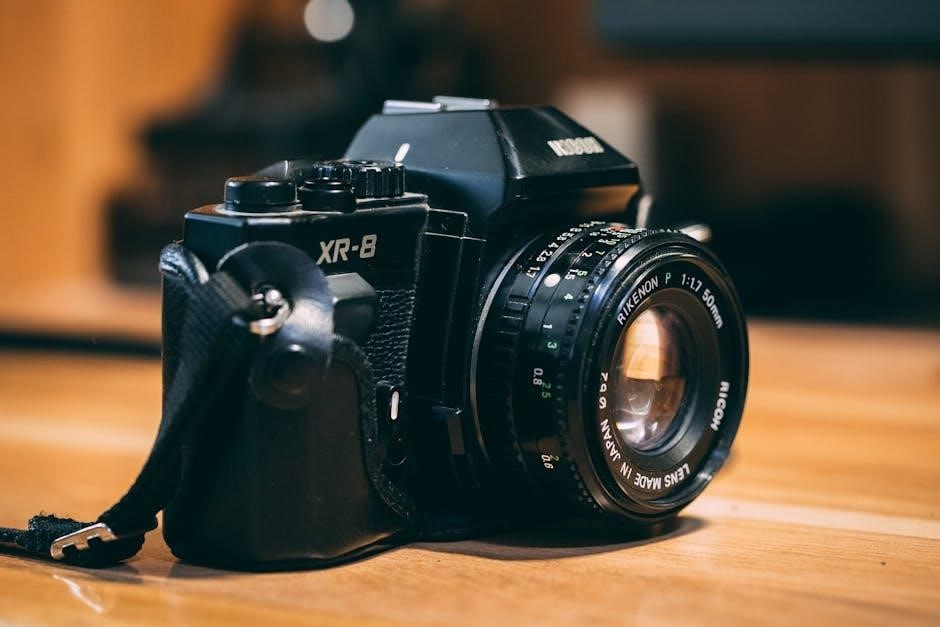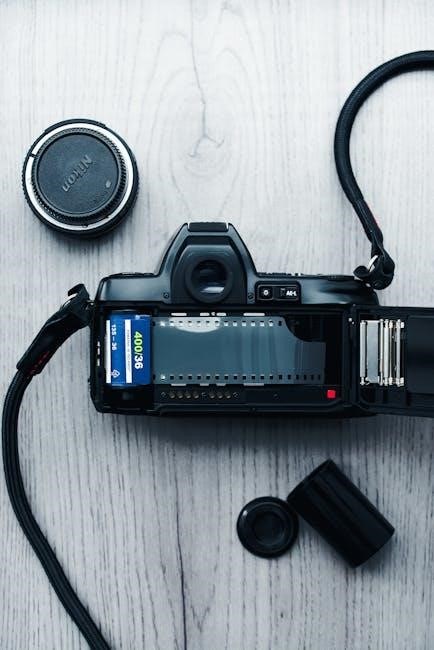Nikon D610 Manual: A Comprehensive Guide
Welcome to the comprehensive guide for the Nikon D610! This manual provides detailed instructions, helpful tips, and troubleshooting advice to maximize your camera’s potential. Master every feature and unlock stunning image quality.
The Nikon D610 is a versatile full-frame DSLR camera designed for both enthusiast photographers and professionals. Known for its excellent image quality and robust performance, it offers a compelling blend of features for various photographic applications. This guide will walk you through every aspect of the D610, from basic setup to advanced techniques.
Whether you’re capturing landscapes, portraits, or action shots, understanding your camera is crucial. The D610 boasts a 24.3-megapixel sensor, delivering sharp and detailed images. Its autofocus system ensures accurate and fast focusing, while various shooting modes cater to different skill levels. This manual will help you explore these features in depth. We will also guide you through using the Nikon Manual Viewer 2 app for mobile access to the manual.

Understanding the Basics
Before diving into advanced techniques, it’s essential to grasp the fundamental aspects of the Nikon D610. This section covers the camera’s layout, key features, and initial setup for optimal performance.

Camera Overview and Key Features
The Nikon D610 is a full-frame DSLR known for its excellent image quality and robust performance. It boasts a 24.3-megapixel sensor, capturing detailed and vibrant photos. Its key features include a wide ISO range, allowing for great low-light performance and versatile shooting in various conditions.
The D610 also offers a fast and accurate autofocus system, ensuring sharp images even with moving subjects. Its durable build quality makes it suitable for demanding shooting environments; The camera supports various Nikon lenses, providing flexibility and creative options. Its user-friendly interface makes navigation simple.
Additional features include Full HD video recording capabilities and various shooting modes for different scenarios. The camera’s compatibility with the Nikon Manual Viewer 2 app allows for easy access to the user manual on mobile devices. The D610 is a reliable tool for both enthusiasts and professionals.
Initial Setup and Configuration
Before embarking on your photographic journey with the Nikon D610, proper initial setup is essential. Start by inserting a fully charged battery and a compatible SD card. Next, power on the camera and set your preferred language, date, and time through the menu options.
Customize the viewfinder display settings to suit your preferences. Adjust the diopter for optimal clarity. Explore the menu to configure basic settings such as image quality, image size, and file naming conventions. Familiarize yourself with the various buttons and dials on the camera body.
Consider setting up your preferred shooting mode, such as aperture priority or manual mode. Ensure that the autofocus settings are appropriate for your typical shooting scenarios. These initial configurations will lay the groundwork for a smooth and personalized shooting experience with the Nikon D610.

Shooting Modes and Settings
Explore the Nikon D610’s versatile shooting modes. From automatic scenes to full manual control, understand how to leverage aperture, shutter speed, and ISO for creative and technically sound images.
Auto and Scene Modes
The Nikon D610 offers a range of automatic and scene modes, perfect for beginners or when quick adjustments are needed. In Auto mode, the camera intelligently selects the optimal settings for various shooting conditions, ensuring well-exposed and sharp images without manual intervention. This mode simplifies photography, allowing users to focus on composition and capturing the moment.
Scene modes provide pre-programmed settings tailored to specific scenarios, such as portrait, landscape, sports, and night photography. Each scene mode automatically adjusts parameters like aperture, shutter speed, and white balance to achieve the best results for the selected scene. For instance, the portrait mode softens skin tones and creates a shallow depth of field, while the landscape mode enhances colors and maximizes sharpness.
Using these modes, photographers can effortlessly capture stunning images in diverse environments. These modes offer a user-friendly approach, making them ideal for everyday photography.
Manual Mode (M): Aperture and Shutter Speed Control
Manual mode (M) on the Nikon D610 grants you complete creative control over your images by allowing you to independently adjust both aperture and shutter speed. Aperture, measured in f-stops (e.g., f/2.8, f/8), controls the size of the lens opening, impacting both the amount of light entering the camera and the depth of field. A wider aperture (smaller f-number) lets in more light, creating a shallow depth of field, ideal for portraits with blurred backgrounds.
Shutter speed, measured in seconds or fractions of a second (e.g., 1/200s, 1s), determines how long the camera’s sensor is exposed to light. Faster shutter speeds freeze motion, while slower shutter speeds allow more light in and can create motion blur.
Mastering Manual mode enables you to precisely control exposure and achieve desired effects. Experiment with different combinations of aperture and shutter speed to create unique and artistic photographs.
Aperture Priority (A) and Shutter Priority (S) Modes
Aperture Priority (A) mode on the Nikon D610 allows you to set the aperture while the camera automatically selects the corresponding shutter speed for proper exposure. This mode is perfect for controlling depth of field. Choose a wide aperture (low f-number) for shallow depth of field, blurring the background and isolating your subject. Select a narrow aperture (high f-number) for greater depth of field, keeping both foreground and background sharp, ideal for landscapes.
Shutter Priority (S) mode lets you set the shutter speed while the camera automatically adjusts the aperture. This is useful for controlling motion blur. Use a fast shutter speed to freeze action or a slow shutter speed to create motion blur, like silky smooth water in a waterfall.
Both modes offer a balance between manual control and automated assistance, providing flexibility in various shooting scenarios.

Focusing and Metering
Master the art of sharp images and accurate exposure with your Nikon D610. Dive into understanding autofocus systems, metering modes, and how they work together to capture perfectly focused and well-exposed photographs.
Autofocus System: Points and Modes
The Nikon D610 boasts a sophisticated autofocus (AF) system that allows for capturing sharp images in various shooting scenarios. Understanding the AF points and modes is crucial for achieving optimal focus. The D610’s AF system offers a range of focus points spread across the frame, enabling precise focusing on your subject, even when it’s not in the center.
Different AF modes cater to diverse shooting situations. Single-servo AF (AF-S) is ideal for stationary subjects, locking focus once achieved. Continuous-servo AF (AF-C) is designed for moving subjects, continuously adjusting focus as the subject moves. Auto-servo AF (AF-A) intelligently switches between AF-S and AF-C based on subject movement.
Furthermore, the D610 provides various AF-area modes, such as single-point AF, dynamic-area AF, auto-area AF, and 3D-tracking. Single-point AF allows you to select a specific focus point. Dynamic-area AF uses surrounding focus points to assist in tracking moving subjects. Auto-area AF automatically selects the focus point. 3D-tracking tracks the subject as it moves across the frame, maintaining focus.
Metering Modes: Understanding Exposure

The Nikon D610 offers various metering modes that determine how the camera measures the light in a scene to calculate the optimal exposure settings. Understanding these modes is essential for achieving well-exposed photographs.
The D610 features three primary metering modes: Matrix metering, Center-weighted metering, and Spot metering. Matrix metering is the default mode and analyzes the entire scene to determine the best overall exposure. It’s suitable for most shooting situations.
Center-weighted metering focuses on the center of the frame, giving it more weight in the exposure calculation. This mode is useful when the subject is in the center and you want to ensure it’s properly exposed.

Spot metering measures the light at a very small point in the center of the frame. This mode is ideal for situations where the subject is much brighter or darker than the surrounding area, allowing for precise exposure control. Mastering these metering modes will give you greater creative control over your images.

Image Quality and Settings
Explore the Nikon D610’s image quality settings to fine-tune your photos. Adjust ISO for optimal noise levels, and master white balance for accurate color reproduction. Unleash your creative vision!
ISO Settings and Noise Management
Understanding ISO is crucial for managing image quality on your Nikon D610. ISO determines the camera’s sensitivity to light. Lower ISO values (e.g., ISO 100) produce cleaner images with minimal noise, ideal for well-lit conditions. Higher ISO values (e.g., ISO 3200 or higher) are necessary in low-light situations, allowing you to capture images without a flash. However, increasing ISO introduces noise, which appears as graininess or speckling in your photos.
The D610 offers a wide ISO range, allowing flexibility in various shooting scenarios. Experiment with different ISO settings to find the optimal balance between brightness and noise. Utilize the camera’s noise reduction features to minimize noise at higher ISO levels. Consider shooting in RAW format to retain more image data, providing greater flexibility for noise reduction during post-processing. Mastering ISO settings ensures you capture the best possible image quality in any lighting condition.
White Balance Adjustment
White balance is a critical setting on your Nikon D610 that ensures accurate color rendition in your images. Different light sources emit different color temperatures, which can affect the overall color cast of your photos. White balance adjustment corrects these color casts, making white objects appear white and ensuring natural-looking colors throughout the image.
The D610 offers several white balance presets, including Auto, Incandescent, Fluorescent, Direct Sunlight, Flash, Cloudy, and Shade. The Auto white balance mode typically works well in many situations. However, for more precise control, you can select a specific preset or use Custom white balance to calibrate the camera to a particular light source. Experiment with different white balance settings to achieve the desired color accuracy and creative effect in your photographs. Mastering white balance is essential for capturing true-to-life and visually appealing images.

Advanced Features
Explore the advanced capabilities of your Nikon D610! Delve into custom settings, utilize the Nikon Manual Viewer 2 app, and discover hidden functionalities to elevate your photography skills.
Using Nikon Manual Viewer 2 App
The Nikon Manual Viewer 2 app is a valuable tool for accessing your Nikon D610 manual on the go. Available for both iOS (iPhone, iPad, iPod touch) and Android devices, this application allows you to download and view the camera’s manual offline.
This eliminates the need to carry a physical copy or rely on an internet connection while you are in the field. To acquire the app, visit the App Store or Google Play and search for “Nikon Manual Viewer 2”. Once installed, you can download the specific manual for the Nikon D610, ensuring you always have a readily accessible reference guide.
The app provides a user-friendly interface for browsing the manual’s contents, searching for specific topics, and quickly finding answers to your questions about the D610’s features and functions. Take full advantage of this digital resource to enhance your understanding and mastery of the Nikon D610.
Custom Settings Menu
The Nikon D610’s Custom Settings Menu grants users extensive control over various camera functions, tailoring the camera’s behavior to individual shooting preferences and needs. Navigating this menu allows photographers to personalize button assignments, adjust autofocus behavior, fine-tune exposure settings, and modify display options.
By delving into the Custom Settings Menu, users can optimize the D610 for specific photographic genres, such as portraiture, landscape, or sports photography. Detailed customization options include adjusting the sensitivity of autofocus tracking, setting bracketing increments, and configuring the information displayed in the viewfinder.
Experimentation with these settings is encouraged to discover the optimal configuration for your unique shooting style. Consult the D610’s manual, either in print or via the Nikon Manual Viewer 2 app, for in-depth explanations of each setting and its impact on camera performance.

Troubleshooting
Encountering issues with your Nikon D610? This section provides guidance on identifying and resolving common problems. Find solutions for error messages, focusing difficulties, and connectivity issues, ensuring smooth operation of your camera.
Common Issues and Solutions
This section addresses prevalent issues encountered by Nikon D610 users, offering practical solutions for seamless operation. A common problem involves autofocus malfunctions, often resolved by cleaning lens contacts or selecting appropriate focus modes. Exposure inaccuracies might stem from incorrect metering settings; explore different metering modes for balanced results.
Image quality concerns, such as excessive noise, can be mitigated by adjusting ISO levels or employing noise reduction features. If your camera fails to recognize the memory card, verify its compatibility and ensure proper insertion. Battery drain problems may necessitate a battery replacement or optimized power-saving settings.
Furthermore, connectivity challenges with computers or mobile devices can frequently be overcome by updating drivers or utilizing Nikon’s Manual Viewer 2 app. Addressing these common issues ensures a smoother photography experience with your Nikon D610.
Firmware Updates and Support
Keeping your Nikon D610’s firmware up-to-date is essential for optimal performance and access to the latest features. Regularly check Nikon’s official website for firmware updates specifically designed for the D610. Firmware updates often address bugs, improve compatibility with lenses and accessories, and enhance overall camera functionality.
Nikon provides comprehensive support resources for D610 users. Their website offers downloadable manuals in multiple languages, including English, providing detailed information on camera operation and troubleshooting. You can also find FAQs, tutorials, and contact information for Nikon’s customer support team.
Consider exploring online photography forums and communities where D610 users share their experiences and solutions to common problems. Nikon’s Manual Viewer 2 app, available for iOS and Android, offers convenient access to camera manuals on your mobile device. Utilizing these resources ensures your D610 remains in top condition.

